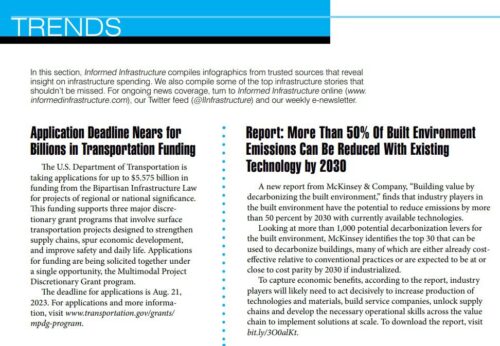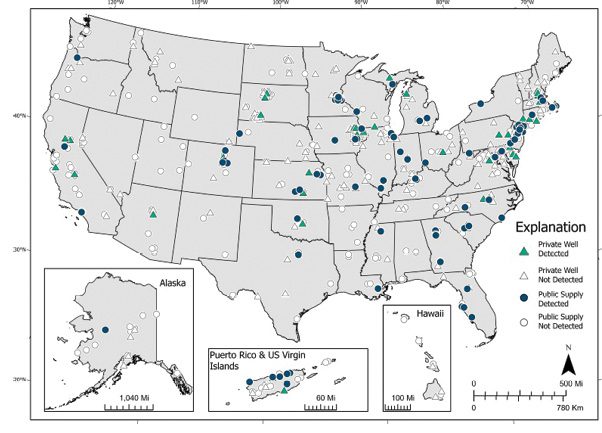Trends August 2023

Application Deadline Nears for Billions in Transportation Funding
The U.S. Department of Transportation is taking applications for up to $5.575 billion in funding from the Bipartisan Infrastructure Law for projects of regional or national significance. This funding supports three major discretionary grant programs that involve surface transportation projects designed to strengthen supply chains, spur economic development, and improve safety and daily life. Applications for funding are being solicited together under a single opportunity, the Multimodal Project Discretionary Grant program.
The deadline for applications is Aug. 21, 2023. For applications and more information, visit www.transportation.gov/grants/mpdg-program.
Report: More Than 50% Of Built Environment Emissions Can Be Reduced With Existing Technology by 2030
A new report from McKinsey & Company, “Building value by decarbonizing the built environment,” finds that industry players in the built environment have the potential to reduce emissions by more than 50 percent by 2030 with currently available technologies.
Looking at more than 1,000 potential decarbonization levers for the built environment, McKinsey identifies the top 30 that can be used to decarbonize buildings, many of which are either already cost-effective relative to conventional practices or are expected to be at or close to cost parity by 2030 if industrialized.
To capture economic benefits, according to the report, industry players will likely need to act decisively to increase production of technologies and materials, build service companies, unlock supply chains and develop the necessary operational skills across the value chain to implement solutions at scale. To download the report, visit bit.ly/3O0alKt.
ASCE Introduces Standards to Avoid Flooding, Prevent Collapse

Photo (top) and computer simulation (bottom) of a structural component experiencing forces similar to those in a building collapse scenario. In the photo, a reinforced concrete test specimen (representing part of a building’s structural frame) undergoes mechanical deformations comparable to what might be experienced following the loss of a load-bearing building column. The lower image shows the calculated concrete damage from a high-fidelity model of the test specimen (red indicates the areas with the most severe damage, and blue indicates undamaged concrete).
The American Society of Civil Engineers (ASCE) announced that its most widely used standard has a newly released supplement. “ASCE/SEI 7-22: Minimum Design Loads and Associated Criteria for Buildings and Other Structures” has been updated with new flood-load provisions that protect against 500-year flood events—a significant improvement over the 100-year flood hazard referenced in the previous edition. Supplement 2 of ASCE/SEI 7-22 is available as a free download at bit.ly/44zmeOl.
In addition, ASCE released the “ASCE/SEI 76-23 Standard for Mitigation of Disproportionate Collapse Potential in Buildings and Other Structures,” the first national building standard of its kind. Developed over the course of a decade and informed by research led by the National Institute of Standards and Technology (NIST), the standard provides design requirements and guidance to keep small, isolated failures in a structure from propagating and bringing down the entire building or a major part of it—a phenomenon the standard defines as disproportionate collapse. For more information on ASCE/SEI 76-23, visit bit.ly/3XZS84h.
Tap Water Study Detects PFAS ‘Forever Chemicals’Across United States

This U.S. Geological Survey (USGS) map shows the number of PFAS detected in tap water samples from select sites across the nation. The findings are based on a USGS study of samples taken between 2016 and 2021 from private and public supplies at 716 locations. The map does not represent the only locations in the United States with PFAS. High concentrations of some PFAS, a group of synthetic chemicals used in a wide variety of common applications, may lead to adverse health risks in people, according to the U.S. Environmental Protection Agency.
The National Institute of Building Sciences (NIBS) released its second bi-annual Social Equity Survey, which was created in partnership with 26 organizations in the built environment and initially developed to advance work on the issue of social equity in the industry.
By aggregating and analyzing nearly 7,000 U.S. survey responses, the report helps provide insights into the diversity of the built environment and provide a baseline for future initiatives to improve social equity. Access the full report at bit.ly/3q2ibva.
TOP STORIES
The following are the top stories from the last few months (in terms of traffic) on the Informed Infrastructure website. This also reflects key coverage areas that are regularly refreshed online and via our weekly e-newsletter. Simply search key words on Informed Infrastructure online to find the full story.
Buildings
- Purdue Research Buzzing About Construction Lessons Taken From Bees, Honeycombs
- AISC Releases New Version of Specification for Structural Steel Buildings (ANSI/AISC 360-22)
- America’s Cement Manufacturers Launch Microsite to Showcase Crucial Early Progress in Realizing Carbon Neutrality
- AISI Standards Council Establishes New Group to Address Energy Standards for Building Envelopes
- Updated ASTM Standard Available for HDPE HDD Projects
Transportation
- HDR Creates Industry-First Customizable Multimodal Tool for Analyzing Airport Landside Traffic
- Proposed Expanded EPA Authority Over Roadside Ditches Endangers Goals of Bipartisan Infrastructure Law, ARTBA Says
- Auburn University Partners with Tensar International to Develop Performance-based Resilience Evaluation Program (PREP) for Transportation Infrastructure
- Henderson Engineers Delivers Sustainable Operations for New Terminal at Kansas City International Airport
- Video: How State DOTs Address Risk and Resilience
Water
- Elevate Your Standards in 2023 With Standard Methods for the Examination of Water and Wastewater, 24th Edition
- Cleaning Contaminated Water With Flax Shives
- New Report From US Water Alliance and Stantec Offers Innovative Model for Water Pricing Equity
- ACWA Power Adds Record Desalination Capacity for 2022
- Brown and Caldwell to Develop Southern California Drought Mitigation Study
Tools and Technology
- CompassCom Unveils Next-Gen CompassLDE Connectors for Real-Time Asset Tracking in Esri ArcGIS Solutions
- Seequent Unveils SLOPE3D: Advanced Stability Analysis Tool to Help Engineers Design Safer Slopes
- FARO Releases Hybrid Reality Capture
- Launch of Trimble Unity AMS Provides Electric Utilities with Enterprise Asset Management Solution to Improve Reliability and Efficiency
- Cupix Adds CupixWorks to Bentley’s Powered by iTwin Program


